How To Remove Mehendi: 11 Easy At-Home Techniques
If you are starting to dislike your fading design, try these sure-fire ways to get it off.

Image: Midjourney/ StyleCraze Design Team
I wish I had learned how to remove mehendi before getting into a spot. You will understand why a little further down the story. So, like other girls, I had the dream of getting married to Mr. Perfect. The extravagant traditions, a host of relatives, grand gastronomic spreads — the list goes on! Mine was one of those big fat Indian weddings that included all of these! And with traditions comes the ritual of decorating the hands with mehendi. Ah! The joys of being a bride! I had beautiful designs of mehendi intricately applied all over my palms and forearms, till a little over my elbows, and my feet were adorned with henna up to the anlkles.

The extravagant traditions, a host of relatives, grand gastronomic spreads — the list goes on! Mine was one of those big fat Indian weddings that included all of these! And with traditions comes the ritual of decorating the hands with mehendi. Everything seemed great until after I was married, and my new husband and I were venturing out for our first holiday together – our honeymoon. Suddenly it struck me: how would I dress in all of that hand-picked beachwear with Mehendi adorning my limbs? And mind you! The color was fantastic when it was done, but it had begun to fade and blotch six days into the wedding, and it was not the prettiest sight! I knew something had to be done, and my mehendi problem had to be tackled, so I took it to my best friend, Google.
These are some really amazing methods of removing mehendi from the hands that I found and tried. And they worked! Now, when I look back at the photographs and look for the almost negligent color of henna, I can’t help but smile. My experience moved me to put together this list for all the brides with mehendi concerns. I hope these tricks help you as much as they helped me. Read on…
 Keep in Mind
Keep in Mind- Pre-Prepare: Pre-Prepare Finish beauty treatments such as waxing, pedicure, and manicure before applying the mehndi. Too much exposure to water and creams can fade the color.
- Comfortable Clothing: Pre-Prepare Bridal mehndi application may take hours of sitting at one place, so make sure you’re wearing comfortable clothing.
- Test The Mehndi: Pre-Prepare Test the quality of the henna for skin infections or allergies and the intensity of the stain before applying it all over.
- Caution: Pre-Prepare Do not moisturize your hands before the mehndi application as it affects the absorption.
In This Article
How To Remove Mehendi
Given here are the 11 easy mehendi removal techniques:
- Cleansing Regularly With Antibacterial Soap
- A Salt Water Soak
- Scrub Using A Face Exfoliator
- Warm Water Rinse
- A Vigorous Massage With Olive Oil
- Bleaching The Color With Lime
- Using A Tooth Paste Pack
- A Baking Powder Solution
- Using Bleach To Remove The Stains
- Using A Hydrogen Peroxide Rub
- Eroding The Color With Chlorine
Key Takeaways
- Olive oil, lemon juice, and vinegar may be useful in removing the mehendi stain.
- Scrubbing with a pumice stone or sandpaper gently may also help
- Keep the area moisturized to avoid dryness post-scrubbing
- Baking powder, bleach, and soaps may also be useful in lightening the stain.
1. Cleansing Regularly With Antibacterial Soap
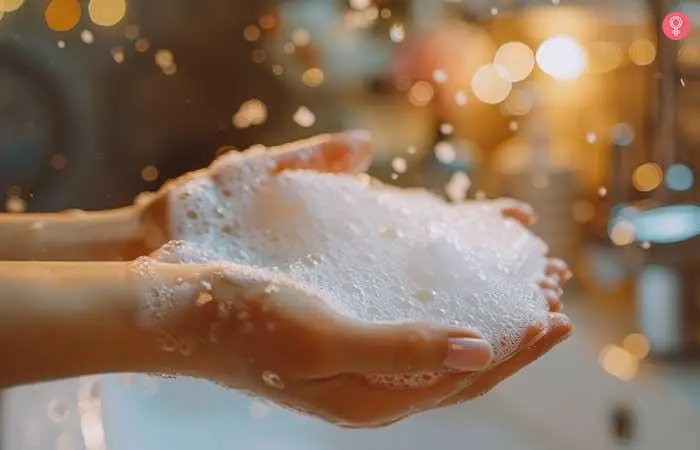
Washing your hands is one of the best habits you can cultivate, especially if you want your mehendi to fade off soon.
What You Need To Do
Wash your hands with an antibacterial soap from time to time. It is the most convenient (but slow) method of mehendi removal. You can also add natural oils or scrubs, as they help exfoliate and speed up the fading process.
How Often You Must Do It
For best results, make sure you wash your hands once every hour, or about 10-12 times a day until your mehendi fades away.
Why It Works
Antibacterial soaps are slightly harsh, and they also exhibit exfoliating properties. This will erode the color and help dissolve remove it faster than usual.
Caution
Washing your hands often could make your hands dry since mehendi already makes your skin extremely dry. Make sure you moisturize your hands well if you adopt this method of removal.
2. A Salt Water Soak
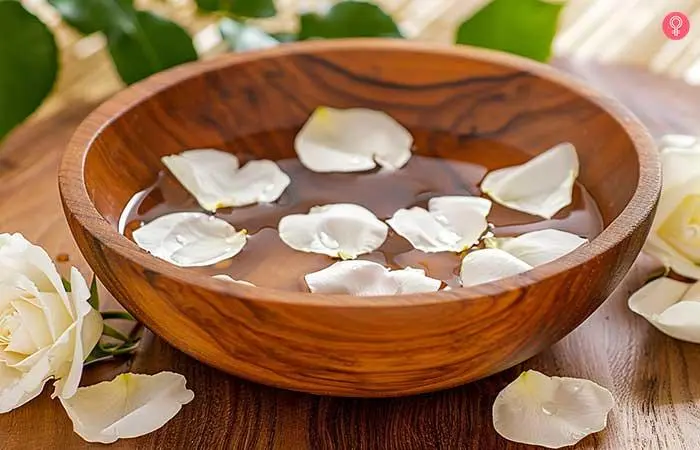
Salt is known to reduce pain/impurities and cleanse your body, thoroughly and naturally.
What You Need To Do
- Take a bowl full of sea salt and water solution.
- Keep your hands soaked in the solution for about 20 minutes, and then pat your hands dry.
How Often You Must Do It
For best results, make sure you soak your hands in salt water once every day, until the color completely fades away.
Why It Works
Salt is a powerful cleanser, and it will make the color diffuse in water, thus gradually fading the stain.
Caution
Long periods of soaking can make your skin shrivel and extremely dry. So don’t forget to use an emollienti Substances or products such as oil, lotion, and creams that help soften the skin by increasing its moisture levels. to follow up the soak.
 Quick Tip
Quick Tip3. Scrub Using A Face Exfoliator
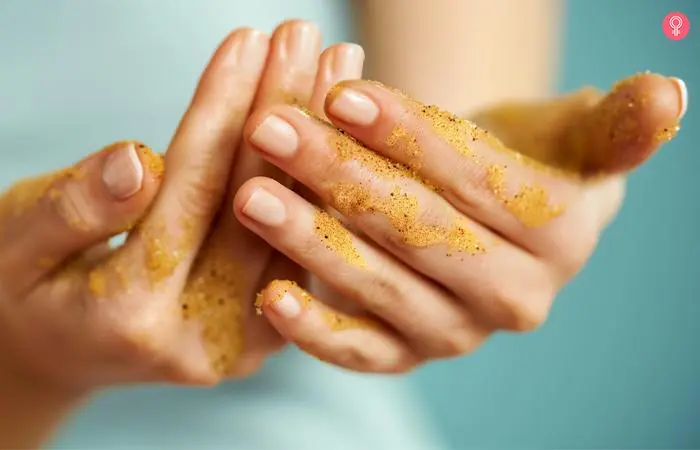
Are you the one who is wondering on how to remove henna from hands quickly? Then exfoliation is the key to remove henna as soon as you possibly can. So it is a good idea to use your face scrub to do it.
What You Need To Do
Gently massage your hands with your favorite exfoliator for about two to three minutes.
How Often You Must Do It
Do it every day until your mehendi fades away.
Why It Works
The beads present in the scrub gently remove the stain molecules, causing the mehendi to fade away.
Caution
It is best to do an allergy test before you use an exfoliator. Be gentle. If you rub too vigorously, you might end up bruising yourself. Remember, you will see the mehendi fade to a large extent, but it will not vanish.
4. Warm Water Rinse
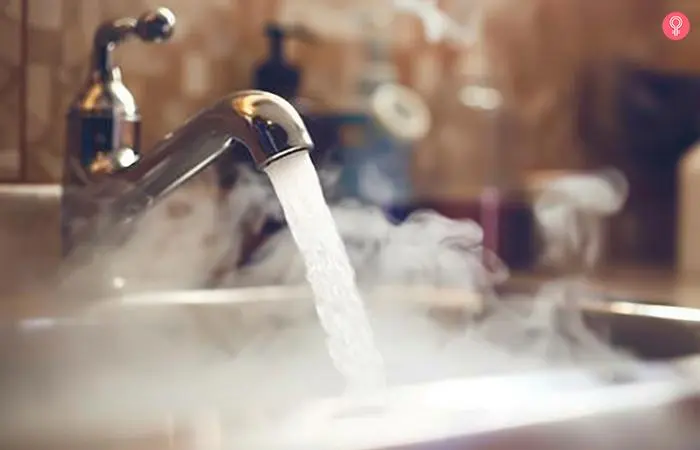
Warm water is another amazing remedy for a host of different problems. Whether it is to heal excruciating pains or to cleanse intensely, warm water does its job well.
What You Need To Do
- Dip your hands in warm water soak for about 15-20 minutes.
- Rub your hands with a loofah.
This procedure will not eliminate remove the mehendi stains instantly, but it will definitely hasten the process.
How Often You Must Do It
For best results, soak your hands in warm water only once a day. You could wash the stains off your hands with warm water two to three times a day.
Why It Works
Warm water will loosen the henna particles, making it extremely easy to remove when you scrub off.
Caution
Make sure the water isn’t too hot, else you will end up burning your hands. Also, be gentle with the loofah. You don’t want to hurt yourself. Moisturize your hands thoroughly after you have soaked them to avoid dry skin.
5. A Vigorous Massage With Olive Oil

Olive oil is a miracle oil, and one of its significant benefits is that it helps in the removal of mehendi. The best part is, this one has no side effects.
What You Need To Do
- Soak a cotton swab in olive oil and swipe it across your hands. You could add some salt to the oil to further hasten the process.
- Allow the oil to penetrate for about 10 minutes.
- You may or may not wash your hands after the process. The oil might just get absorbed into your skin.
How Often You Must Do It
For best results, you could repeat this procedure many times in a day.
Why It Works
Olive oil works as an excellent emulsifieri Surface-level agents that combine liquids of different densities, such as oil and water, and help stabilize the mix. for henna stains. It is also the simplest and gentlest method of removing mehendi stains.
Elaine, a travel and lifestyle blogger, shared her first experience of getting a henna tattoo in one of her blog posts. As the tattoo began fading away, she used a DIY removal method and observed, “I decided to try olive oil which, like henna, has been used on skin since ancient times. It’s loaded with nutrients, is a natural humectant, and is rich in antioxidants. I applied it to the back of my hand, left it for 10 minutes, then gently scrubbed it off using a face cloth and hand soap. It worked like a charm (i)!”
 Quick Tip
Quick Tip6. Bleaching The Color With Lime
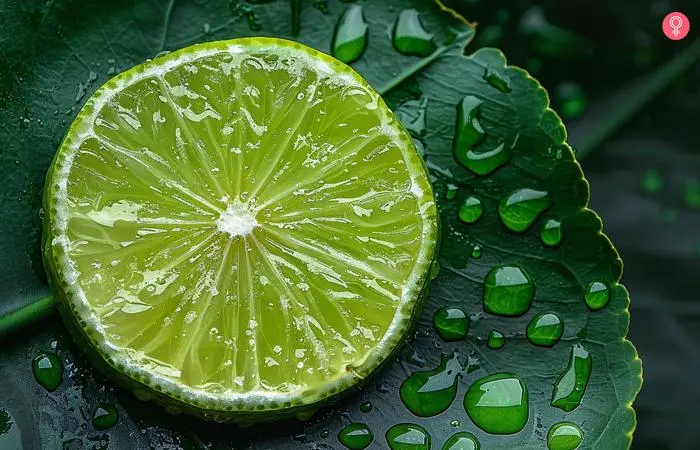
Lime or lemon is another cleansing agent that has many uses and benefits. It is also a great ingredient when you want get rid of your mehendi.
What You Need To Do
There are two approaches to this technique. You can either squeeze out the lemons and rub the juice directly on your hands, or soak your hands in water and squeeze out the lemon juice in the bowl of water.
How Often You Must Do It
For best results, use this technique once or twice a day.
Why It Works
Lemon and lime are known to be bleaching agents. The juice of either of them will bleach the color effectively.
Caution
Make sure your hands are free of cuts or nicks. Even if you have a small, negligible cut, the lemon juice will make the wound hurt. Also, don’t forget to moisturize well once you finish the peel-off procedure.
7. Using A Toothpaste Pack

Yes, you use it to brush your teeth, but you will be surprised to know that toothpaste works extremely well as a cleansing agent to clean your jewelry, remove certain stubborn stains, and even to quickly remove the mehendi on your hands.
What You Need To Do
All you need to do is to apply generous amounts of toothpaste wherever the mehendi stains are. Allow it to dry, and then rub your hands to remove the color.
How Often You Must Do It
This method of removal is extremely effective, so you should get the best results the first time you try it. But, in case it doesn’t work, you can try it again after giving a day’s gap.
Why It Works
Toothpaste has abrasives and detergents that pull out the stains and lighten the mehendi.
Caution
Do a patch test before you use it to check for allergic reactions. Also, toothpaste can be harsh on your skin, so don’t forget to moisturize once you finish the procedure.
8. A Baking Powder Solution
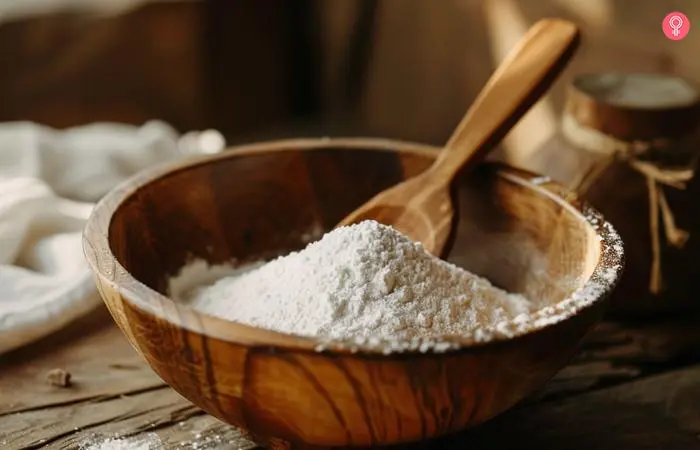
Baking soda, like the products mentioned above, is extremely versatile and is handy to solve a wide range of problems. And it is exceedingly effective in mehendi removal.
What You Need To Do
- Make a thick paste using baking soda and lemon juice, and apply it all over the required areas.
- Leave it on for 10 minutes, or until it dries.
- Then, use a loofah, and exfoliate in a circular motion.
- Rinse it off with warm water.
How Often You Must Do It
You should get great results in one go, but you can repeat this process if necessary.
Why It Works
Baking soda and lime are both bleaching agents and stain removers, so they work in removing the mehendi particles from within.
Caution
Baking soda is very harsh on your skin. Hence, it might be a good idea to use this technique only if all else fails, and only if the removal is absolutely urgent. If you must use baking soda for henna removal, make sure you moisturize your skin thoroughly after.
9. Using Bleach To Remove The Stains

Bleaching is the most common and effective method of removing mehendi.
What You Need To Do
- Take any regular bleach (one that is used for the face and hands), and mix it as per instructions.
- Apply it on the mehendi.
- Once it dries, rinse your hands with cool water.
How Often You Must Do It
Bleach is also harsh on the skin, so try this procedure only once. You should be able to see great results.
Why It Works
Bleach contains abrasives that nullify and erase any colorant. It works the same way with mehendi and successfully strips away the color.
Caution
It is advisable to do a patch test and check for allergic reactions before you use this technique. You should be warned that bleach causes a burning, itchy sensation, even if you are not allergic to it. Avoid sun exposure immediately after you bleach your hands. And don’t forget to moisturize.
10. Using A Hydrogen Peroxide Rub
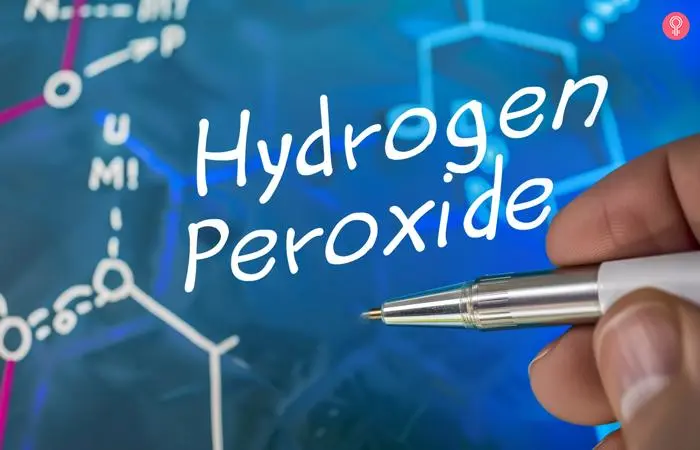
Hydrogen peroxide is a non-toxic, benign solution that is easily available at most drug stores.
What You Need To Do
- Soak a cotton swab in hydrogen peroxide and rub it on your hands smoothly.
- Allow it to rest for a few minutes, and then wash off. You will notice instant results.
How Often You Must Do It
You will see instant results, so it is best to use this technique only once.
Why It Works
Hydrogen peroxide also contains bleaching agents that successfully work in removing organic stains.
Caution
This technique does not work for all skin types. So do a patch test first before applying it on your entire hand.
11. Eroding The Color With Chlorine
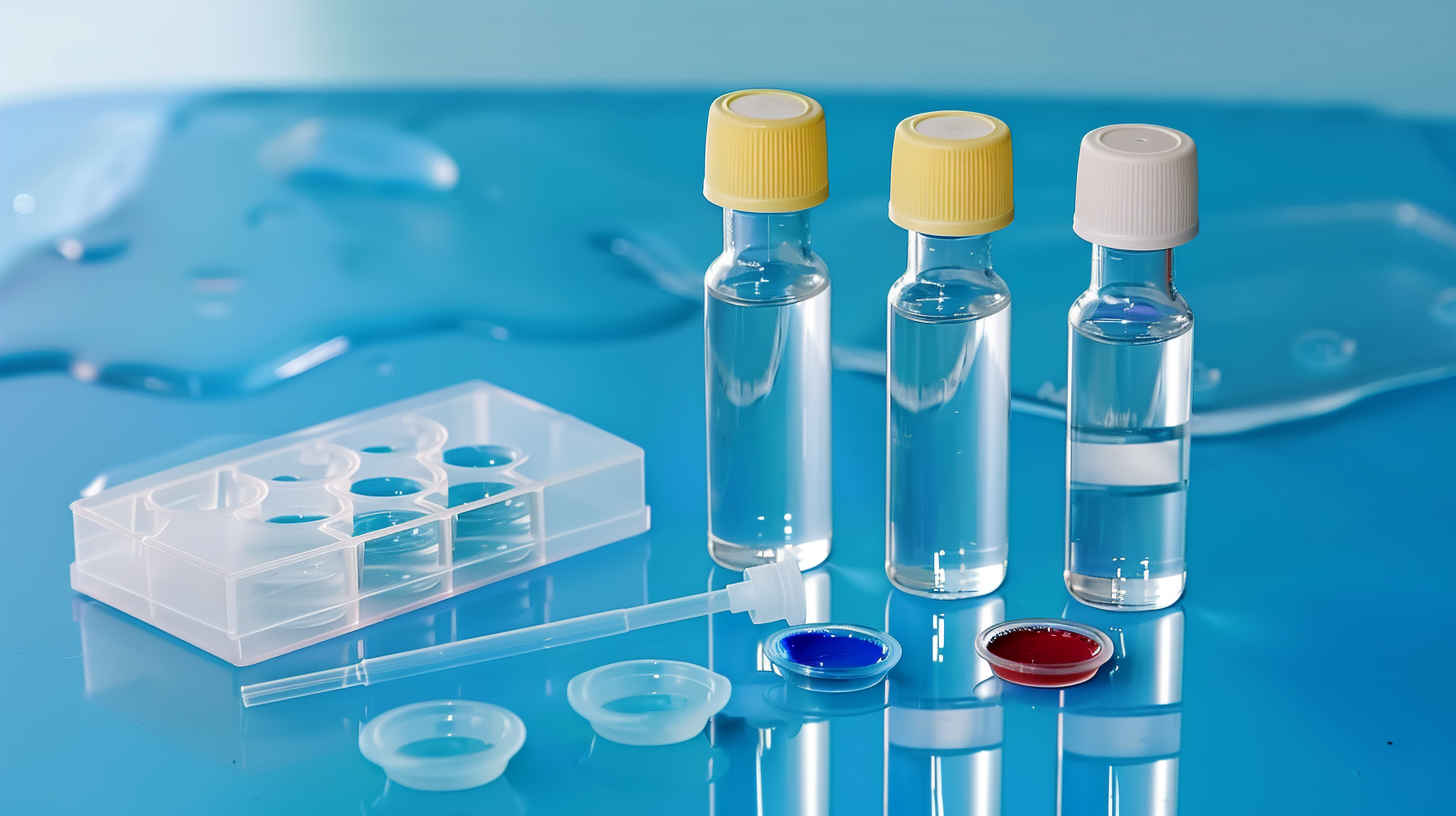
Going for a swim when you are desperate to get that mehendi off your hands might be a good idea – no kidding!
What You Need To Do
Of course, you could go for a swim to use the chlorine water removal technique. If not, just buy some chlorine from your local chemist and soak your hands in its solution for about 20 minutes. You will notice the mehendi lighten, almost magically.
How Often You Must Do It
This method also offers great results, so you might not need to repeat it. But if you have to, do it once every day until your mehendi completely fades away.
Why It Works
Chlorine is an amazing disinfectant and is one of the most advanced halogens of the century. When it comes in contact with the mehendi stains, it causes certain reactions that help fade the color away.
Caution
You must definitely do a patch test and check for allergic reactions before you try this technique. If it works for you, make sure you moisturize your hands well after you use it.
If you want to know how to remove henna dye from your hair, the next section discusses a few solutions.
How To Remove Henna From Hair?
So, you have rocked that gorgeous henna color for quite some time, but now you are ready for a change. While henna benefits for hair are quite well known, like adding shine and promoting growth, it can get a little tricky to remove from your locks. Here are a few ways to fix a henna hair dye problem:
- Do a hot mineral oil treatment by applying the oil on the hair, wrapping it with a shower cap, leaving it on for 2-3 hours or overnight, and washing it out with a clarifying shampoo. You may need to do it a few times every 3-4 days.
- Apply a non-oxidizing dye to cover up the henna. This is better than other oxidizing hair dye formulas that may turn your henna-dyed hair blue.
- Grow the hair out and chop away the stained hair.
You may use some of the above remedies like bleach, toothpaste, baking powder, etc. However, do a patch test as some of these ingredients are abrasive and may dry out your hair, making it brittle.
Let’s take a look at a few things you need to avoid when removing henna or mehendi at home.
Things To Avoid When Removing Mehendi At Home
Here are a few things you should avoid when trying to remove henna at home:
- Don’t Use Harsh Chemicals: While it may be tempting to use strong chemicals to remove henna quickly, they may damage your skin and cause irritation or burns. Avoid using products like bleach, acetone, or other harsh chemicals to remove henna.
- Don’t Scrub Too Hard: When trying to remove henna, it’s important to be gentle with your skin. Scrubbing too hard can cause redness, irritation, and even bleeding in some cases. Instead, use a soft cloth or exfoliating sponge to gently rub the area in circular motions.
- Don’t Expose Your Skin To Hot Water: Hot water can cause henna to stain your skin even more, as it opens up the pores and allows the pigment to seep deeper into the skin. Instead, use cool or lukewarm water when trying to remove henna.
- Don’t Rush The Process: Henna can be stubborn to remove, and it may take some time for the pigment to fade completely. Trying to rush the process by using harsh chemicals or scrubbing too hard can actually make the stain worse. Be patient and gentle with your skin, and give it time to naturally exfoliate the henna over several days.
- Don’t Pick At The Henna: Picking at the henna can cause scarring or discoloration of the skin. Instead, allow the henna to fade naturally, or try gentle removal methods, such as using oil or lemon juice to help speed up the process.
Infographic: Top 4 Ways To Remove Mehendi From Your Hands At Home
Applying mehendi to your hands is one of the best ways to celebrate a special occasion and express your style. However, it is also crucial to understand how to take off remove your mehendi once the occasion is over since mehendi won’t go with your regular outfit. We have rounded up the top 4 ways to remove mehendi easily at home. Check out the infographic below to know more!
Some thing wrong with infographic shortcode. please verify shortcode syntax
Mehendi looks great when it is freshly put on your hands or legs. Unfortunately, it does not look so good when it is fading. The designs fade, blotch, and appear ugly. However, you can avoid this if you know how to remove it. The hacks and tricks mentioned above will help you easily remove mehendi at home without much effort. All the ingredients listed above are easily available in your kitchen and would not take a lot of time. Also, do not apply anything that causes allergic reactions to your skin.
Frequently Asked Questions
Does nail polish remover remove henna?
Removing henna stains on the nails can be a breeze with the help of a nail polish remover containing acetone. Simply soak a cotton ball in the remover and gently dab the stained area. This will help fade the stain without causing any harm to your nails. Be gentle and use the nail polish remover in moderation, as overuse of acetone can make nails dry and brittle.
Can sanitizer remove mehendi?
Yes, hand sanitizer can remove mehendi stains. Apply it in a generous amount, let it sit, and gently rub off with a cotton ball and warm water. This is a convenient and effective alternative, and the results may vary depending on the skin type.
Can Tiger Balm remove henna?
No. In fact, Tiger Balm and other similar products are great for enhancing the appearance of henna stains and making them last long. Over time, the henna stain will naturally fade through exfoliation or you can choose to use specific henna removal products to speed up the process.
How long does it take for mehendi to fade naturally?
Mehendi typically fades on its own within 1-3 weeks depending on your skin type and how frequently you wash or exfoliate the colored area. Regular exposure to water and natural skin shedding also play a role in how quickly the stain fades.
Illustration: Simple And Safe Ways To Remove Mehendi At Home

Image: Dall·E/StyleCraze Design Team
Mehndi can be fun, but the after-effects? Not as much. Check out this simple and safe video tutorial on how to remove those stubborn henna stains instantly.
Personal Experience: Source
StyleCraze's articles are interwoven with authentic personal narratives that provide depth and resonance to our content. Below are the sources of the personal accounts referenced in this article.
i The ancient art of hennahttps://edebock.blog/2025/09/03/the-ancient-art-of-henna/
Read full bio of Simone de Vlaming
Read full bio of Shalini Roy
Read full bio of Shatabdi Bhattacharya
Read full bio of Anu Pallavi










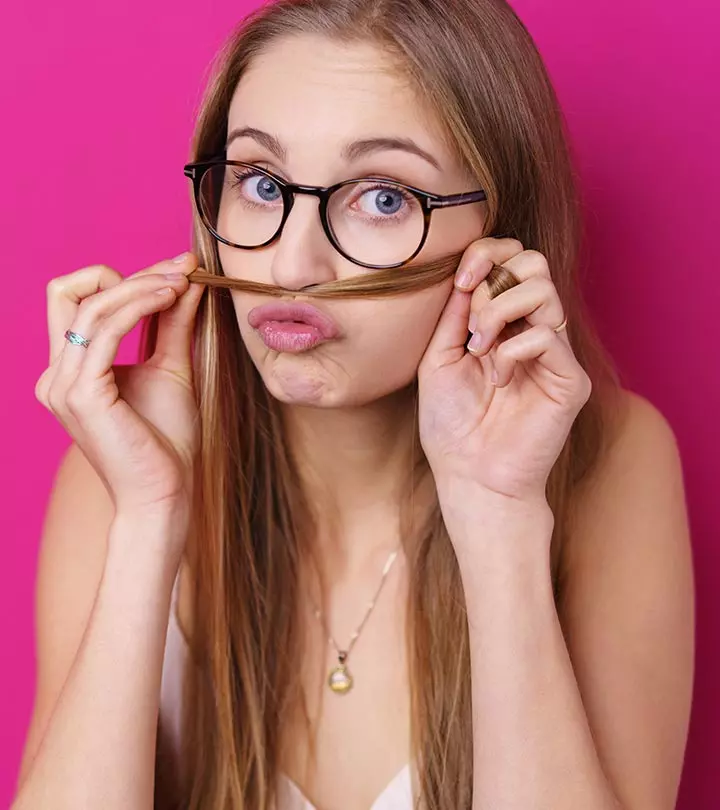

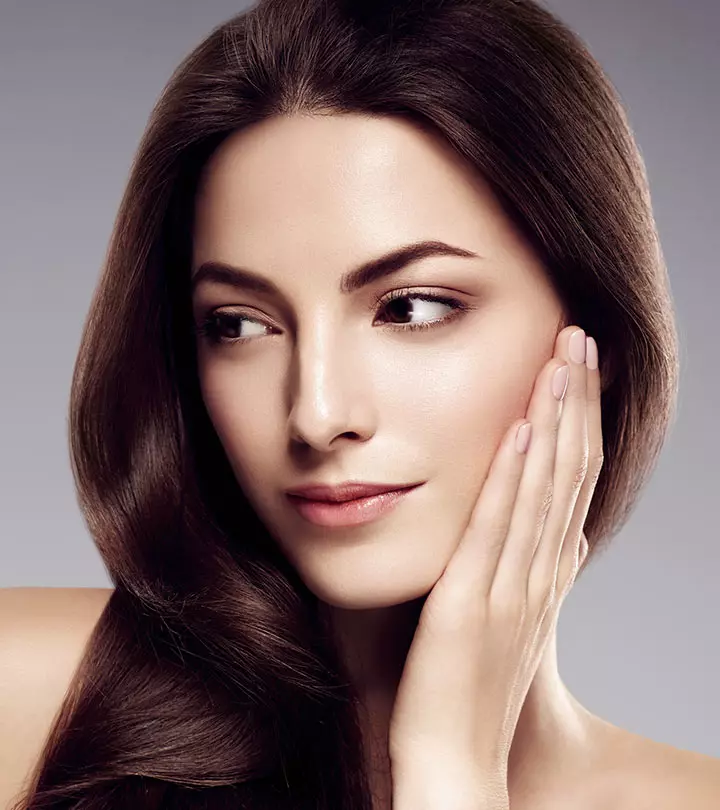




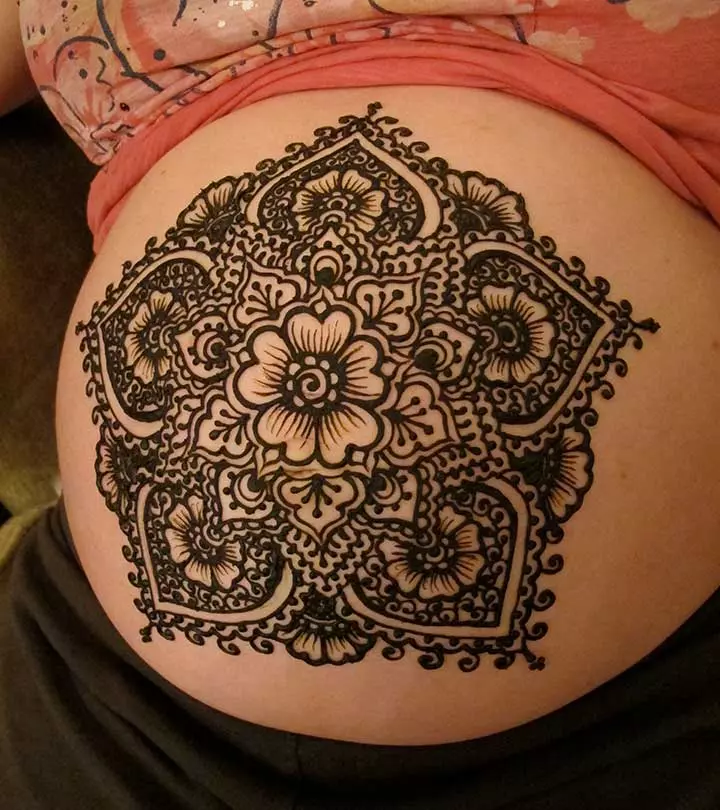
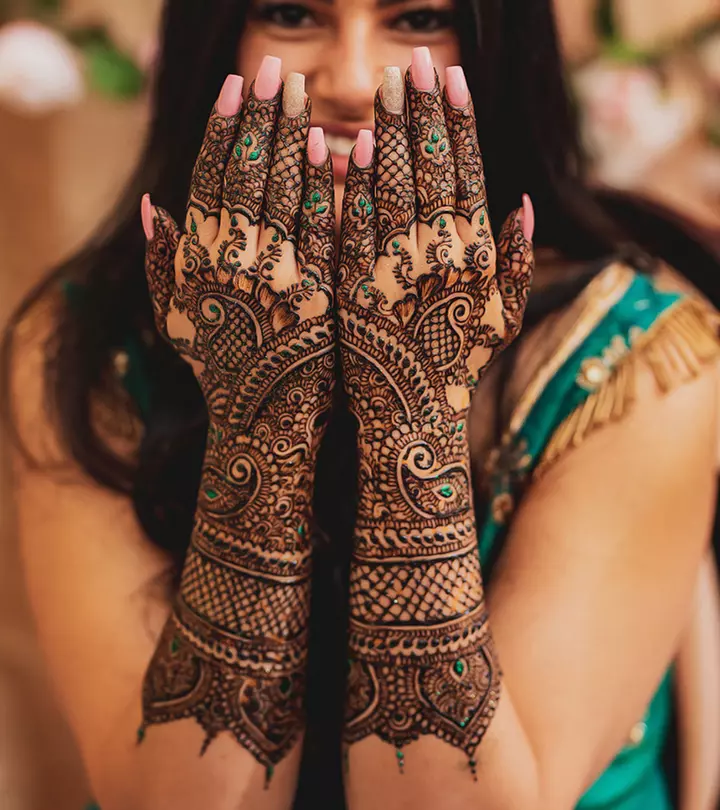
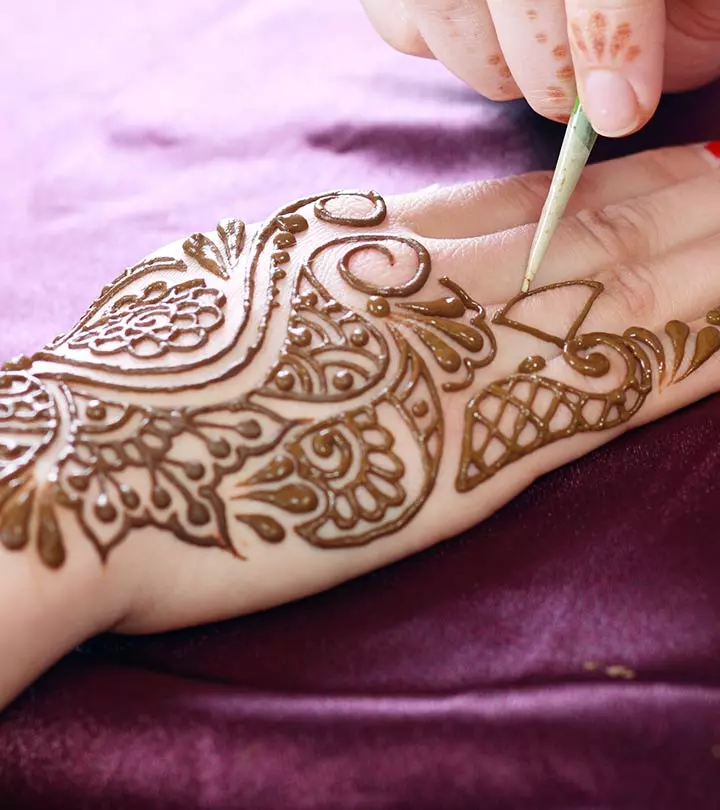

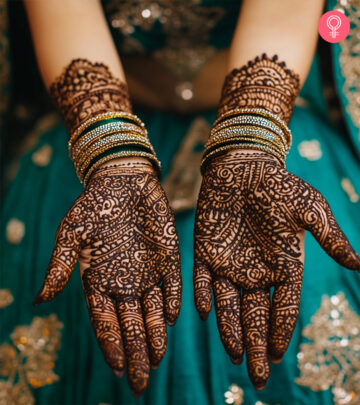


Community Experiences
Join the conversation and become a part of our empowering community! Share your stories, experiences, and insights to connect with other beauty, lifestyle, and health enthusiasts.